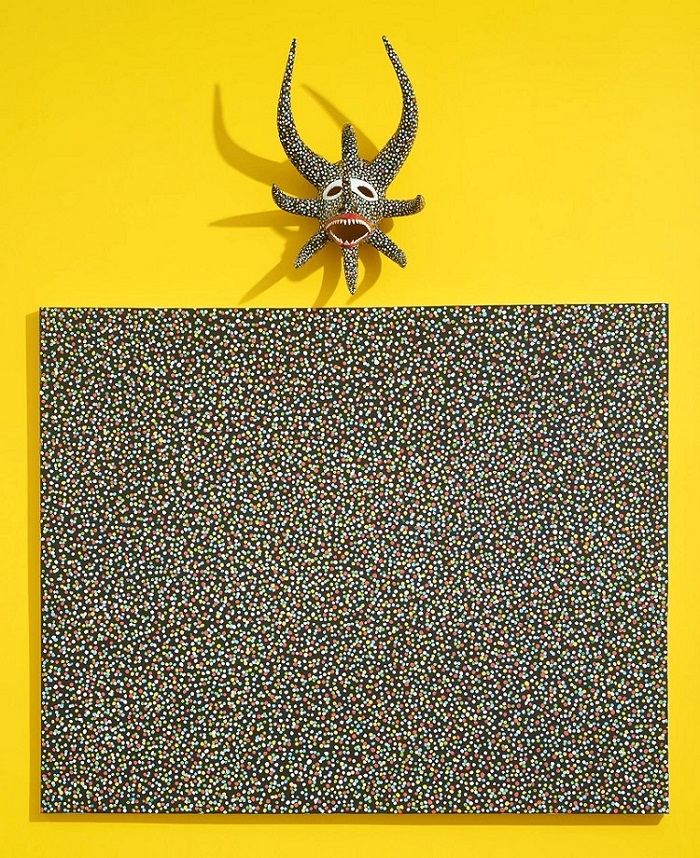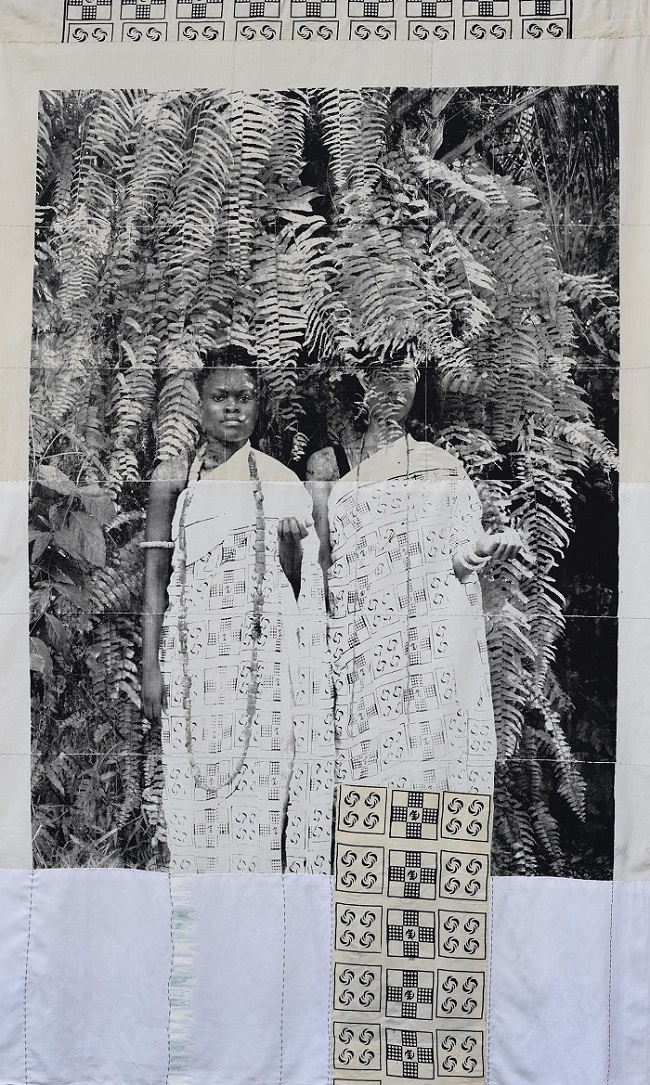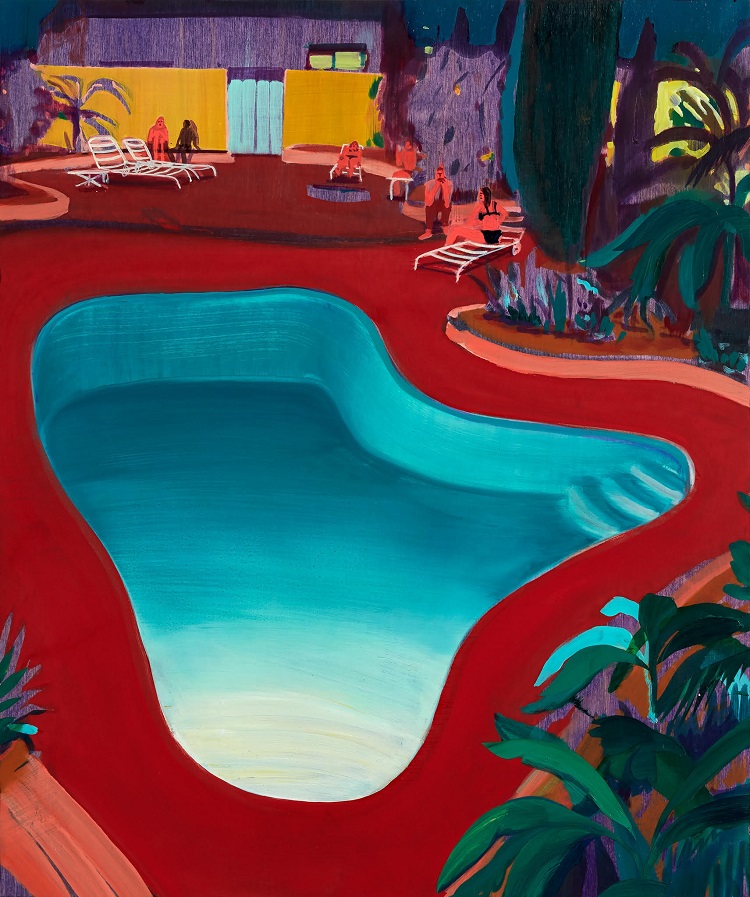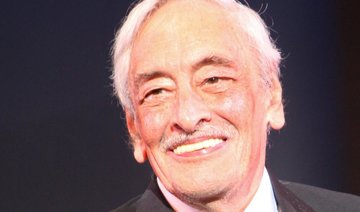DUBAI: Art lovers, curators, collectors and enthusiasts are rejoicing as the biggest and most globally diverse art fair is set to open from March 21 to 24 at Madinat Jumeirah. Under the patronage of Sheikh Mohammed bin Rashid Al-Maktoum, Art Dubai’s lineup this year will feature a record 104 galleries from 47 countries. Art lovers can enjoy unique and new contemporary artists and a significant contingent of returning galleries.
Founded in 2007, it’s become one of the leading international fairs in the arts calendar and features a great range of galleries in one setting. Imagine a compiled list of the most prominent art galleries from Buenos Aires, Argentina to Kolkata, India to Turin, Italy and more, all in one fair over three days. This year will feature new first-time participants from Iceland, Ethiopia and Kazakhstan alongside the returning 77 galleries.

Jesús Bubu Negrón, Ethnographic Abstractions (2016) in the Contemporary Hall. (Photo courtesy: Henrique Faria)tion
“For our 2018 edition, we will be launching Residents, a pioneering and unique platform that brings together different energies, synergies, geographies and artistic practices which aren’t usually seen together in one place,” said Pablo del Val, Art Dubai’s artistic director.
Art Dubai’s halls are divided into three main halls, Contemporary, Modern and, for the first time, Residents.
Art Dubai’s Contemporary’s diversity is signified by its strong representation from the Middle East, North Africa and South Asia. Galleries include Selma Feriani Gallery (Tunis, London), Gypsum Gallery (Cairo), Artwin Gallery (Moscow), Artside Gallery (Seoul), Gallery One (Ramallah), the Athr Gallery Jeddah, Saudi Arabia and Gallery 57 from Accra, Ghana, among others.
The artists range from household names to new, up-and-coming artists with a wide range of artistic media: painting, drawing, installations, photography and more.
Art Dubai’s Modern will feature a record-breaking 16 galleries exhibiting artists from 14 countries. Participating galleries will present renowned Modernists from the Middle East such as Gebran Tarazi, Abdel Hadi El-Gazzar, Hamed Abdalla and others. Leading Modernists from South Asia include Zahoor ul Akhlaq, Anwar Jalal Shemza and M.F. Husain, while notable African Modernists will include Mohammed Naghi, Reinata Sadimba, Ernesto Shikhani and more.

Zohra Opoku, Debie, (2017) in the Residents Hall. (Photo courtesy: Zohra Opoku and Mariane Ibrahim Gallery)Caption
Art Dubai’s Director Myrna Ayad said: “It’s very exciting for us to witness the growing appreciation of modern masters from the region and we are pleased to be the only platform in the world to showcase these museum-quality pieces in our largest ever Modern section, which has been the most oversubscribed to date. Serving as an educational platform and theoretical framework for the works on show, Art Dubai Modern will be accompanied by our second annual Modern Symposium at the fair this year.”
For its 12th edition, Art Dubai is presenting a gallery to showcase its 11 solo gallery presentations by artists who took part in their residency program. The program’s aims are to support artists by giving them a platform to develop their practice and create new bodies of work, inspired and influenced by their stay in the UAE. Their work will be presented by the artists’ respected galleries in a special exhibition accompanied by a range of public events and open studios hosted by the residency spaces.
Art Dubai aims to create a dialogue, engage socially in matters of art and, more importantly, educate on the significance of art in our everyday lives. Dubai is an international melting-pot and a capital for art creators, curators and directors from all over the world to meet and present their finest to the public, all in one place.

Jules de Balincourt, Valley Pool Party (2016) in the Contemporary Hall. (Photo courtesy: The artist and Victoria Miro Gallery)Caption
Art Dubai 2018: Big diary date for art curators, collectors and enthusiasts
Art Dubai 2018: Big diary date for art curators, collectors and enthusiasts

French Algerian actress Sofia Boutella begins year with ‘SAS Rogue Heroes’

DUBAI: French Algerian actress Sofia Boutella started the new year on a high note with the premiere of season two of the BBC series “SAS Rogue Heroes.”
“Happy New … SAS season 2 is out … and Happy New Year,” she wrote on Instagram this week, sharing on-set pictures of herself and her co-stars from the military drama, which chronicles the exploits of the British Army’s special forces unit.
Series two, created by Steven Knight (“Peaky Blinders”), picks up with British troops in the spring of 1943 during World War II.
Returning for the sequel are actors Jack O’Connell, Connor Swindells, Dominic West and Sofia Boutella, who reprises her role as French intelligence agent Eve Mansour.
Commissioned by the BBC, the show is based on Ben Macintyre’s best-selling book of the same name, with season two having been directed by Stephen Woolfenden.
Boutella most recently starred “The Killer’s Game,” which hit cinemas in September, and Netflix’s “Rebel Moon — Part 2: The Scargiver.”
In the sci-fi adventure — a sequel to last year’s “Rebel Moon — Part One: A Child of Fire” — a peaceful colony on the edge of a galaxy finds itself threatened by the armies of a tyrannical ruling force.
Kora, played by Boutella, has assembled a small band of warriors — outsiders, insurgents, peasants and orphans of war from different worlds.
Boutella drew on her history as an immigrant. She grew up in Algeria during its civil war and later moved to France and found herself navigating the complexities of adapting to a different culture.
“Having left Algeria young, when I go back there I don’t feel like I belong to Algeria. And then, in France, I don’t feel like I belong to France because I didn’t grow up there,” she told Arab News in a previous interview.
Boutella has learned to embrace her rootlessness, though. “I feel like I belong to this planet. I have the freedom to travel wherever I want, without any limitation,” she said. “But sometimes, I miss the proximity and attachment that people have to their country.”
Kora was not Algiers-born Boutella’s first role as a sword-wielding extraterrestrial. The actress, who at the age of 10 fled to Paris with her family during the Algerian civil war, is known for her breakout performance in the Oscar-nominated film, “Star Trek Beyond,” in which she portrayed the fierce alien warrior, Jaylah.
Iran artist’s vision for culture hub enlivens rustic district

- Arabesque patterns and relief faces carved with intricate details and painted in vivid hues of greens, pinks, blues, and purples now adorn the walls
SHIRAZ, Iran: In the winding alleys of southern Iran, artist Adel Yazdi has taken it upon himself to turn his rustic old neighborhood into a cultural and tourist hub through vibrant paintings and carved relief faces.
Narenjestan, a neighborhood characterized by crumbling, uninhabited houses, is nestled in Shiraz, a southern city celebrated for its historic architecture, lush gardens, and revered poets.
“Most of the dilapidated walls in old Shiraz have no historical value,” said Yazdi, a bushy-bearded, bespectacled 40-year-old artist who has dedicated himself to revitalizing Narenjestan.
Over the years, Yazdi has turned the long-neglected neighborhood walls into a vivid visual tapestry “telling the stories of the people living here,” he said.
Arabesque patterns and relief faces carved with intricate details and painted in vivid hues of greens, pinks, blues, and purples now adorn the walls.
With its striking designs and bright colors, Yazdi’s art can be reminiscent of Surrealism. It often comes across as surprising, showcasing a different side of Iran’s artistic heritage that goes beyond the conventional focus on traditional architecture.
The artwork includes the face of Scheherazade, Yazdi said, referencing the legendary storyteller from the “One Thousand and One Nights” collection of folktales.
Yazdi’s work stands out in Shiraz, where graffiti and murals are rare, and it has become a social media sensation and a tourist attraction.
Yazdi said he drew inspiration from the Pompidou Center in Paris, a cultural hub that transformed the heart of the French capital in the 1970s. He hopes his efforts can turn Shiraz’s alleyways into a more vibrant cultural center.
At his residence, visitors are particularly drawn to what Yazdi calls “the Finger Room.”
Inside, he installed around 14,000 finger sculptures on the ceiling, all pointing downward.
“The room is inspired by the legend of an angel that counts raindrops with thousands of fingers,” he said, referring to a religious fable.
“These fingers constantly remind us that the present moment is precious and that we must seize it.”
REVIEW: ‘Squid Game’ enters a holding pattern

- Second season of the hit Netflix show feels tentative, ahead of its upcoming finale
LONDON: The success of “Squid Game” in 2021 made a second season an inevitability, rather than a mere possibility proffered by a hopeful epilogue scene. But because this smash-hit show came out of South Korea, there was also an optimistic air to its steadily approaching release — could this addictively bleak dystopian thriller sidestep a lot of the Hollywood pitfalls and deliver a second season that was at least the equal of the first?
Although it’s a sidestep of its own, the answer is… we’re not sure yet. And that’s because, although it’s billed as season two, these seven new episodes were shot back-to-back with season three (coming in 2025 and confirmed to be the last). So what you’re essentially getting here is the setup for the big finale still to come. That perhaps explains why, though the first season dropped viewers into the murderous titular competition pretty quickly, the actual ‘game’ of the second season of “Squid Game” doesn’t start until midway through the third episode. Before that, we’re reintroduced to main protagonist Seong Gi-hun (Lee Jung-Jae, still far and away the best thing about the show). Having won the first season’s brutal series of children’s games (for which the losers’ penalty is death), Gi-hun is spending his reward money trying to bring down the organizers of the competition, teaming up with season one detective Hwang Jun-ho (Wi Ha-joon) in an attempt to topple the shady cartel that is pressganging cash-strapped Koreans into murdering each other for money. When his plan to catch the game’s Front Man fails, he instead joins the latest intake, intent on helping the contestants escape with their lives.
It’s an odd choice to spend so long building up to the competition — and even dallying on whether it can be proved it even exists — when that’s what viewers are here for. Once the games get going, “Squid Game” is as breathless and shocking as ever, and with a new cast of characters, there are fresh backstories to mine and some pretty pointed social commentary on greed, capitalism and social care (Korean commentators have suggested that the subtitles miss a few of the nuances of the script, which may be why some of the satire seems a little on the nose). Perhaps acknowledging what audiences will remember, there’s also a few decent twists that deserve to remain a surprise.
But while season two of “Squid Game” is still great television, there’s no small amount of bloat here — and a sense of treading water for the final round still to come.
Incoming: The hottest TV shows set to air in 2025

- From long-awaited returns to emotional send-offs, via some intriguing new material, here are the series we can’t wait to see this year
‘Severance’ season 2

Starring: Adam Scott, Zach Cherry, Britt Lower
The first season of this darkly humorous sci-fi tinged psychological thriller brought deserved critical acclaim for its creator Dan Erickson, and directors Ben Stiller and Aoife McArdle, as well as its brilliant cast. The show focuses on a group of employees at a mysterious corporation who have agreed to undergo a procedure known as “severance,” which divides their memories between their time in and out of work, thus creating two different lives, with distinct personalities, but who begin to question both the ethics of the procedure, and their own reasons for accepting it.
‘The Last of Us’ season 2

Starring: Bella Ramsey, Pedro Pascal, Gabriel Luna
Not just a great video game adaptation, but a great show in general. This post-apocalyptic drama is set a couple of decades into a pandemic in which a fungal infection turns its hosts into zombie-like monsters and centers on a teenage girl (Ellie) who is somehow immune to infection and the smuggler (Joel) who agreed to escort her on a journey across the US and gradually becomes a father figure to her. The chemistry between Ramsey as Ellie and Pascal as Joel is utterly convincing and the series, like the games it is based on, is a quietly devastating work of art.
‘Stranger Things’ season 5

Starring: Winona Ryder, David Harbour, Millie Bobby Brown
One last visit to the Upside Down, and one last visit to Hawkins, Indiana, to catch up with psychokinetic Eleven and her friends as they fight to save the Earth from the aforementioned alternate dimension. Over the last decade, “Stranger Things” has been one of the biggest shows in the world — an irresistible mix of horror, sci-fi, coming-of-age drama, and Eighties nostalgia. Here’s hoping showrunners The Duffer Brothers can stick the landing.
‘The Bear’ season 4

Starring: Jeremy Allen White, Ebon Moss-Bachrach, Ayo Edebiri
After the dizzying heights reached in its first two seasons, the third outing of this hyper-tense kitchen-based drama (it barely seems worth repeating that — despite its Emmy categorization — “The Bear” really isn’t a comedy) was something of a stagnant disappointment. But a disappointing episode of “The Bear” still beats the best efforts of 90 percent of what’s on television, and it wouldn’t be a great surprise if season four is a triumphant return to form for ace chef Carmy Berzatto as he strives to make a success of his family’s titular restaurant. There’s a lot on the line, though, with season three ending just as Carmy starts to read the make-or-break restaurant review that could mean he loses his financial backer.
‘Zero Day’

Starring: Robert De Niro, Lizzy Caplan, Jesse Plemons
A political conspiracy thriller that looks like being one of the most intriguing new shows of 2025. With a stellar cast and some serious pedigree among the creators — showrunner Eric Newman (“Narcos”), former NBC News president Noah Oppenheim, and The New York Times’ Washington correspondent Michael S. Schmidt — this story focuses on a former US president, George Mullen (De Niro), who is called out of retirement to investigate a cyberattack responsible for killing thousands of Americans.
‘A Knight of the Seven Kingdoms’

Starring: Peter Claffey, Dexter Sol Ansell, Finn Bennett
If “House of the Dragon” isn’t enough “Game of Thrones” universe for you, then here’s another prequel, this time based on George R.R. Martin’s “Tales of Dunk and Egg” novellas — set almost a century before the events of “Game of Thrones. The show will focus on hedge knight Ser Duncan the Tall (Dunk) and his young squire Aegon Targaryen (Egg), who will grow up to become King Aegon V and sit the Iron Throne, and their wanderings across Westeros. Martin has given the show his seal of approval, saying after visiting the set that the cast seemed to have “walked out of the pages of my book.” The approval of the fans may be harder to earn.
‘Black Mirror’ season 7

Starring: Awkwafina, Paul Giamatti, Emma Corrin
Season seven of the acclaimed sci-fi/horror anthology series created by Charlie Brooker is confirmed as returning this year with a run of six episodes, two of which, Brooker told the audience at Netflix’s Geeked Week event in September, are “basically feature-length.” There’s little information about the stories so far, but the little we have is pretty exciting — one will be a sequel to one of the show’s most-loved episodes, the season four opener “USS Callister” (pictured).
REVIEW: ‘Beast Games’ — the biggest prize in TV history, and a telling snapshot of our times

DUBAI: It’s a high bar, but “Beast Games” might be the most cynical TV show ever produced. Amazon — owned by Jeff Bezos; estimated net worth $251 billion — throws a reported $100 million at 26-year-old social-media behemoth Jimmy Donaldson (aka MrBeast; estimated net worth $500 million) so he can make a reality competition show that borrows heavily from a hugely successful fictional South Korean show and gives the “largest ever cast” (1,000 participants) the opportunity to win $5 million (the “largest ever single prize”) and a host of other ‘smaller’ (i.e. still huge) prizes along the way.
Why? Probably not because the studio execs — or Bezos himself — are huge MrBeast fans. But think of all the data to be mined when the latter’s 340 million YouTube subscribers sign up to Amazon Prime — that’s the kind of payoff that makes it worthwhile (and $100 million for Amazon is kind of like a regular person’s $5).
And what do the audience get in return for surrendering their personal info to the rapacious advertiser and retailer? Basically “Squid Game” without any deaths, but with much of that show’s energy and aesthetics. Donaldson and his crew of long-time friends/assistants have built careers out of giving away huge amounts of money to people for completing challenges (or snatching it from them if they fail), and now they’re doing it with higher production values.
The tasks (at least in the first three episodes) are straightforward, childish even (catch a ball; throw a ball into a receptacle…), but the mind games are intense — often, competitors must sacrifice themselves so others can continue. Those that choose to do so look absolutely bereft. If you’re wondering whether anyone involved in “Beast Games” picked up on the fact that “Squid Game” was intended to satirize the spiritual vacuum of late-stage capitalism via the portrayal of the gleeful exploitation of desperate, cash-strapped people for entertainment, we’re guessing the answer’s no.
Still, as a TV show, “Beast Games” is compelling in its way — think “Ultimate Fail” videos crossed with “The Traitors.” It’s slickly packaged and fast-moving (within the first half-hour, half of the contestants are culled), like MrBeast’s YouTube content. The psychology is fascinating — the weird notion so many of the contestants have that they’re “destined” to win a game of mostly chance and not much skill, or that, somehow, “needing” it enough will see them through; or the way that, within a matter of hours, herd mentality and peer pressure make people forget that they’re competing to try and secure life-changing money for their loved ones rather than impress a group of almost-strangers to whom they owe nothing.
“Beast Games” keeps you engaged, then, but it doesn’t keep you invested. That’s partly because Donaldson and co., who come across as affable and a bit goofy online, haven’t made the jump to “traditional” media comfortably. Particularly Donaldson, who, as a gameshow host, lacks warmth and charisma and spends much of his time shouting dystopian catchphrases (“Everyone has a price!” or, gazing down on the contestants from the wall of Beast City, “They look like ants!”).
It will be an enormous success.














